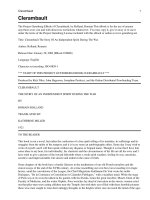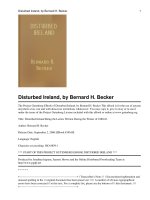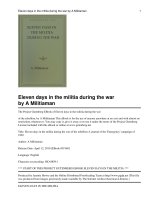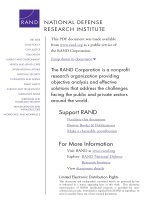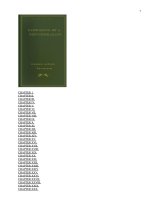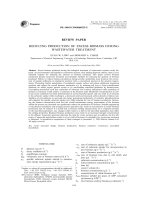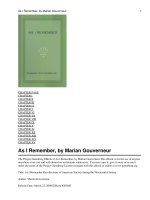ionospheric irregularities during intense magnetic storms
Bạn đang xem bản rút gọn của tài liệu. Xem và tải ngay bản đầy đủ của tài liệu tại đây (4.13 MB, 8 trang )
“main” — 2007/10/8 — 12:52 — page 151 — #1
Revista Brasileira de Geof
´
ısica (2007) 25(Supl. 2): 151-158
© 2007 Sociedade Brasileira de Geof
´
ısica
ISSN 0102-261X
www.scielo.br/rbg
STUDY OF IONOSPHERIC IRREGULARITIES DURING INTENSE MAGNETIC STORMS
Luiz Felipe Campos de Rezende
1
, Eurico Rodrigues de Paula
2
, Inez Staciarini Batista
3
,
Ivan Jelinek Kantor
4
and Marcio Tadeu de Assis Honorato Muella
5
Recebido em 23 fevereiro, 2006 / Aceito em 21 maio, 2007
Received on February 23, 2006 / Accepted on May 21, 2007
ABSTRACT.
The effects of two intense magnetic storms over ionospheric irregularities were analyzed using GPS signal scintillation data from the stations of S
˜
ao Lu
´
ıs
(2.57
◦
S, 44.21
◦
W, dip latitude 1.73
◦
S) in the equatorial region, S
˜
ao Jos
´
e dos Campos (23.07
◦
S, 45.86
◦
W, dip latitude 18.01
◦
S) and Cachoeira Paulista (22.57
◦
S,
45.07
◦
W, dip latitude 18.12
◦
S) both under the Equatorial Ionization Anomaly (EIA), and S
˜
ao Martinho da Serra (29.28
◦
S, 53.82
◦
W, dip latitude 18.57
◦
S), located in
the South of Brazil. Total Electron Content (TEC) data for S
˜
ao Lu
´
ıs and S
˜
ao Jos
´
e dos Campos, were also analyzed. The analyzed storms occurred on October 28-31,
2003 and on November 7-11, 2004. Both storm periods presented two main phases. In the nights of 29/30 and 30/31 of October, during the two storm main phase, it
was observed that TEC over S
˜
ao Jos
´
e dos Campos reached higher values than the TEC for the magnetically quiet day of October 10, due to the effect of eastward electric
field prompt penetration to magnetic equator that intensified the EIA. Compared to a quiet day (Oct 10), scintillation in the GPS signal amplitude due to ionospheric
irregularity, quantified by the scintillation index S4, was stronger for Cachoeira Paulista (under EIA) during the night of 30/31but not for the night of 29/30 and for S
˜
ao
Martinho da Serra was stronger during the nights of 29/30 and 30/31. Scintillation for the nights of 29/30 and 30/31 at these two stations lasted longer than on October
10, reaching the post midnight time sector. During the November 7-11 storm, TEC kept the behavior of a quiet day except during days 10 and 11 (up to 9 UT), when a
large TEC decrease was observed. The GPS scintillation, compared to the quiet day November 19, was larger at the equatorial station of S
˜
ao Lu
´
ıs during the nights of
7/8 and 8/9 and it was completely inhibited for the S
˜
ao Lu
´
ıs and S
˜
ao Jos
´
e dos Campos stations during the nights of 9/10 and 10/11, probably due to action of westward
disturbance dynamo electric field penetration to equator.
Keywords: GPS, ionospheric scintillation, magnetic storm, TEC (Total Electron Content).
RESUMO.
Os efeitos de duas tempestades magn
´
eticas intensas sobre irregularidades ionosf
´
ericas foram analisados usando dados de cintilac¸
˜
ao do sinal de GPS
das estac¸
˜
oes S
˜
ao Lu
´
ıs (2,57
◦
S, 44,21
◦
W, inclinac¸
˜
ao magn
´
etica 1,73
◦
S) na regi
˜
ao equatorial, S
˜
ao Jos
´
e dos Campos (23,07
◦
S, 45,86
◦
W, inclinac¸
˜
ao magn
´
etica 18,01
◦
S)
e Cachoeira Paulista (22,57
◦
S, 45,07
◦
W, inclinac¸
˜
ao magn
´
etica 18,12
◦
S) ambas sob a Anomalia da Ionizac¸
˜
ao Equatorial (AIE) e S
˜
ao Martinho da Serra (29,28
◦
S,
53,82
◦
W, inclinac¸
˜
ao magn
´
etica 18,57
◦
S), localizada no sul do Brasil. Dados de CET (Conte
´
udo Eletr
ˆ
onico Total) tamb
´
em foram analisados. As tempestades analisadas
ocorreram em 28-31 de outubro de 2003 e em 7-11 de novembro de 2004. Ambos per
´
ıodos de tempestades apresentaram duas fases principais. Nas noites de 29/30
e 30/31 de outubro, durante as duas fases principais da tempestade, foi observado que o CET em S
˜
ao Jos
´
e dos Campos alcanc¸ou valores mais altos que do dia 10 de
outubro que foi magneticamente calmo, devido ao efeito de penetrac¸
˜
ao instant
ˆ
anea ao equador magn
´
etico de campo el
´
etrico dirigido para leste e intensificando a AIE.
Comparada a um dia calmo (10 de outubro), a cintilac¸
˜
ao na amplitude do sinal de GPS devido
`
a irregularidade ionosf
´
erica, representada pelo
´
ındice de cintilac¸
˜
ao S4,
foi mais forte em Cachoeira Paulista (sob a AIE) durante a noite de 30/31 mas n
˜
ao para a noite 29/30 e em S
˜
ao Martinho da Serra, durante as noites 29/30 e 30/31.
A cintilac¸
˜
ao para as noites 29/30 e 30/31 nestas duas estac¸
˜
oes tiveram maior durac¸
˜
ao do que para a noite de 10 de outubro, alcanc¸ando o setor das horas ap
´
os meia
noite. Durante a tempestade de 7-11 de novembro, o CET teve o comportamento de um dia calmo, exceto durante os dias 10 e 11 (at
´
e 09 UT), quando uma diminuic¸
˜
ao
significativa de CET foi observada. A cintilac¸
˜
ao, comparada ao dia 19 de novembro que foi calmo, foi maior na estac¸
˜
ao equatorial de S
˜
ao Lu
´
ıs durante as noites de 7/8
e 8/9 e foi completamente inibida para as estac¸
˜
oes de S
˜
ao Lu
´
ıs e S
˜
ao Jos
´
e dos Campos durante as noites 9/10 e 10/11, provavelmente devido
`
a ac¸
˜
ao da penetrac¸
˜
ao ao
equador de campo el
´
etrico do d
´
ınamo perturbado dirigido para oeste.
Palavras-chave: GPS, cintilac¸
˜
ao ionosf
´
erica, tempestade magn
´
etica, CET (Conte
´
udo Eletr
ˆ
onico T
otal).
National Institute for Space Research, INPE, Av. dos Astronautas, 1.758, Jd. da Granja – 12227-010 S
˜
ao Jos
´
e dos Campos, SP, Brazil. Phone: +55 (12) 3945-7165;
Fax: +55 (12) 3945-6990 – E-mails:
1
;
2
;
3
;
4
;
5
“main” — 2007/10/8 — 12:52 — page 152 — #2
152
STUDY OF IONOSPHERIC IRREGULARITIES DURING INTENSE MAGNETIC STORMS
INTRODUCTION
The ionospheric irregularities are generated after sunset over the
magnetic equator due to plasma instabilities and the most im-
portant parameter for their development is the equatorial evening
vertical plasma drift
E × B/B
2
(Fejer et al., 1999) known as
prereversal enhancement in vertical drift, when the eastward elec-
tric field is intensified due to the action of the F-region dynamo.
During magnetic storms strong eastward (westward) electric
field from the magnetosphere (disturbance dynamo) can pene-
trate to equatorial region intensifying (weakening) the upward
plasma drift and consequently triggering (inhibiting) the iono-
spheric irregularities. This subject has been studied by many
authors (Basu et al., 2001a, b; de Paula et al., 2004) since io-
nospheric irregularities cause scintillation in the GPS signal am-
plitude and phase and can affect telecommunication systems,
and magnetically quiet time scintillation pattern can be modified
during storms. The storms also can affect drastically the CET
(Lin et al., 2005). As there is a strong interplay between the
magnetospheric, ionospheric and atmospheric processes, which
are substantially modified during magnetic storms (Abdu, 1997;
Abdu et al., 1991, 2003; Batista et al., 1991, 2006; Tsurutani et
al., 2004) we present in the next sections a short description of
their quiet and disturbed behavior.
During magnetic storms supersonic solar plasma emissions
distort the magnetosphere (see Fig. 1), that is a cavity formed by
the interaction of the solar wind with the Earth’s magnetic field.
The magnetosphere has a long tail, that extends in the opposite
direction to the Sun (Davies, 1990). According to Gonzalez et al.
(1994), a magnetic storm occurs when a long-lasting interplane-
tary convection electric field leads, through a substantial energi-
zation in the magnetosphere-ionosphere system, to an intensified
ring current sufficiently strong to exceed some key threshold of
the quantifying storm time Dst index. Energy from the solar wind
is transferred to the ionosphere-thermosphere-magnetosphere
system, intensifying convection electric fields in the magne-
tosphere and producing an enhancement of particles precipita-
tion, and currents in the high latitude ionosphere. During magne-
tically disturbed periods the magnetospheric shielding layer is not
effective to shield magnetospheric electric fields which therefore
penetrate directly to low latitudes The structure and dynamics of
the thermosphere and ionosphere is globally affected due to the
increase of ionospheric conductivity, the Joule heating and the
ion drag in the upper atmosphere of high latitudes and the distur-
bance dynamo gives origin to westward electric field that pene-
trates to equatorial region that could last up to 30 hours after the
end of the storm main phase. The disturbed thermospheric cir-
culation changes and the thermospheric meridional wind moves
the plasma along magnetic field lines modifying the the neutral
composition distribution and consequently the recombination ra-
tes of ionized species (Fedrizzi, 2003; Fuller-Rowell et al., 2002).
Figure 1 – Earth magnetic field. Source: Davies (1990).
The disturbed magnetospheric electric fields that penetrate
to equatorial ionospheric region affect drastically the prereversal
peak that is an intensification of the vertical plasma drift around
18-21 LT (21 LT corresponds to 24 UT for the Brazilian region un-
der investigation in this work). The prereversal peak is explained
through the action of uniform neutral wind in the F region (see
Fig. 2). According to Farley et al. (1986) the electric field E
z
generated by the F region dynamo (−U × B) is mapped to the
conjugated E-region along magnetic field lines as an electric
field E
θ
directed to the equator. This electric field generates a
low latitude Hall current, J
θφ
, directed to west. A peculiar situ-
ation occurs at regions close to the day-night terminator. Due to
the much larger dayside conductivity (as compared to the night-
side), no current flows in the nocturnal E-region and consequently
negative charge accumulates in the terminator and gives origin to
an E
φ
field and to a current J
φφ
that tries to cancel J
θφ
(shown
in Fig. 2). E
φ
is then mapped back to the F region and it causes,
firstly, an upward E × B drift of the plasma to higher altitudes
and soon after, a downward drift around 21 LT.
At low latitudes the ionosphere presents the Equatorial Io-
nization Anomaly (EIA) or Appleton Anomaly, that consists of
an ionospheric region with high electronic density peaks, obser-
ved around 15 degrees north and south of the magnetic equator.
This electronic density increase in low latitudes has its origin in
Revista Brasileira de Geof
´
ısica, Vol. 25(Supl. 2), 2007
“main” — 2007/10/8 — 12:52 — page 153 — #3
L.F.C. DE REZENDE, E.R. DE PAULA, I.S. BATISTA, I.J. KANTOR and M.T.A.H. MUELLA
153
Figure 2 – Simple model to explain the prereversal peak caused by a uniform wind U. Source: Kelley (1989).
the upward vertical E × B plasma drift of the equatorial F layer.
As previously shown, the zonal electric field that exists in the
equatorial ionosphere is directed to the east during day, creating
an upward E × B/B
2
vertical drift velocity. Soon after the sun-
set, this eastward electric field is intensified (prereversal peak) by
the F region dynamo and the plasma from F region is uplifted to
high altitudes. Meanwhile, the plasma from low altitudes quickly
decline due decreasing of the intensity of incident solar radiation
(Kelley, 1989). After lifting to high altitudes in the equatorial re-
gion, the plasma starts a descent movement along magnetic field
lines. This movement happens due to the action of gravity (g) and
pressure gradient ( p) forces. This phenomenon (the plasma
elevation and the subsequent descent along magnetic field lines
to low latitudes) is known as the fountain effect (see the scheme
in Fig. 3), giving origin to the Equatorial Ionization Anomaly.
Figure 3 – Appleton Anomaly scheme.
The upward vertical plasma drift in the equator after sunset
that gives origin to the prereversal peak, is the main factor res-
ponsible for the plasma irregularity generation (Fejer et al., 1999).
The irregularities in the electronic density causes a GPS signal
to scintillate and the corresponding amplitude pattern which is
elongated in the north-south direction on the grounds drift from
west to east during magnetically quiet period (Kintner etal., 2001).
The ionospheric scintillation can be defined as fluctuations in the
amplitude or phase of a radio wave. As the ionospheric scintilla-
tions are highly dependent of the upward vertical plasma drift in
the equator driven by east-west electric fields, the penetration to
equator of eastward (westward) electric field from magnetosphe-
ric (disturbance dynamo) origin during storms can trigger (inhi-
bit) them. The scintillation amplitude is dependent also from the
background ionization (TEC).
METHODOLOGY
In this work the magnetic indices Dst (Disturbance Storm Time),
Kp (planetarische Kennziffer) and AE (Auroral Electrojet) were
used to analyze the intensity of the storms. Other parameters like
TEC and S
4
scintillation index were used to study the magnetically
disturbed behavior of the plasma and of the ionospheric irregula-
rities, respectively. TEC corresponds to the number of electrons
contained in the column of unitary base that extends from Earth
surface to a determined height in the atmosphere. This parame-
ter is measured in TEC units (1 TECU = 1 × 10
16
electrons/m
2
).
The S
4
index is the normalized standard deviation of the GPS
signal intensity which is measured at one-minute resolution.
We used the double frequency Turbo Rogue ICS-4000Z, Allen-
Osborne Associates receivers to measure TEC and SCINTMON
Brazilian Journal of Geophysics, Vol. 25(Supl. 2), 2007
“main” — 2007/10/8 — 12:52 — page 154 — #4
154
STUDY OF IONOSPHERIC IRREGULARITIES DURING INTENSE MAGNETIC STORMS
Figure 4 – Location of the GPS receivers: SCINTMON () and Allen-Osborne ().
receivers for scintillation monitoring. Turbo Rogue is an opti-
mized receiver for ionospheric TEC measurements that is able to
track up to 8 satellites simultaneously. The SCINTMON receiver
was implemented through an ISA GPS Card (GEC Plessey GPS
Builder-2
TM
). It is able to sample simultaneously signals from up
to 11 satellites. The data are only collected from satellites with
elevation angle higher than 10 degrees. GPS Wide Band Power
(WBP) of L1 (1.57542 GHz) that is transmitted by GPS satellites
is sampled at 50 Hz rate. The SCINTMON receivers data analyzed
were for S
˜
ao Lu
´
ıs, S
˜
ao Jos
´
e dos Campos, Cachoeira Paulista and
S
˜
ao Martinho da Serra stations and TEC data (from Allen-Osborne
receivers) were analyzed for the S
˜
ao Lu
´
ıs and S
˜
ao Jos
´
e dos Cam-
pos stations (see Fig. 4). The disturbed days parameters were
compared to those for quiet days. Prior and post-storm periods
were analyzed.
RESULTS AND DISCUSSIONS
The scintillation period in the Brazilian territory occurs in the
months from September to March, from 21 to 03 UT (18 to
24 LT) and the scintillation amplitude and frequency of occur-
rence increases with the solar flux increase. Scintillation also
presents a dependence with the season and with the latitude. Pre-
vious works (de Paula et al., 2003; Kintner et al., 2007) showed
that the GPS scintillation amplitude is larger under regions with
larger TEC, like under the EIA. There is also a complex depen-
Revista Brasileira de Geof
´
ısica, Vol. 25(Supl. 2), 2007
“main” — 2007/10/8 — 12:52 — page 155 — #5
L.F.C. DE REZENDE, E.R. DE PAULA, I.S. BATISTA, I.J. KANTOR and M.T.A.H. MUELLA
155
dence of the ionospheric irregularities with the magnetic activity,
what is the main topic of this paper. Magnetic storms can inhibit
the irregularities during their period of occurrence or can trigger
irregularities at any month of the year, even during a period when
irregularities are not expected (de Paula et al., 2004). This beha-
vior during storm is very complex because it depends of the
hour of the storm commencement, of the season, and if the storm
occurred in the recovery phase of another storm. During a magne-
tic storm an eastward (westward) electric field of magnetospheric
origin can penetrate to equator through direct penetration (dis-
turbance dynamo) reinforcing (weakening) the normal eastward E
layer during day and F2 layer from18-21 LT electric fields, trigge-
ring (inhibiting) irregularities. Eastward electric field penetration
during magnetic storms also can trigger irregularities during the
midnight-sunrise time sector.
For the October 28-31, 2003 storm, the first main phase
occurred around 0100 UT on 30 of October when Dst reached
–345 nT, the second one (strongest) occurred around 2300 UT
on the same day and reached –401 nT (see Dst index in Fig. 5).
The November 7-11, 2004 strong magnetic storm also presented
two storm main phases. The first one reached –373 nT at 07 UT
on the day 8 and the other –295 nT around 10 UT on day 10.
In Figure 5 are plotted the magnetic indices AE, Kp, and Dst
and the S4 indices for the stations of S
˜
ao Martinho da Serra,
Cachoeira Paulista (close to S
˜
ao Jos
´
e dos Campos) and S
˜
ao Lu
´
ıs
and TEC for S
˜
ao Lu
´
ıs and S
˜
ao Jos
´
e dos Campos, during the storm
period of October 28-31, 2003. The S4 indices represent the
larger values between all available GPS satellites with elevation
angles larger than 40
◦
, for each one minute.
We observed in Figure 5 that TEC had different behavior com-
pared to the reference quiet day of October 10, 2003. Over S
˜
ao
Jos
´
e dos Campos, under the EIA, during the nights of October
29/30 and 30/31, TEC reached higher values than during the day
of October 10, simultaneously with a TEC decrease at equatorial
station of S
˜
ao Lu
´
ıs (see Fig. 5). This is an evidence of magne-
tospheric eastward electric field prompt penetration to low latitu-
des during this storm, intensifying the EIA, and moving plasma
from equator to low latitudes.
During this storm and considering that only S4 larger than
0.2 represents GPS scintillation, it was observed (see Fig. 5)
larger (except for Cachoeira Paulista in the 29/30 night before
02 UT) and longer lasting scintillations at Cachoeira Paulista and
S
˜
ao Martinho da Serra on the nights 29/30 and 30/31 compa-
red to the quiet night (Oct. 10/11). At S
˜
ao Lu
´
ıs, the equatorial
station, the scintillation amplitude was smaller during the nights
of 29/30 and 30/31. Normally at the Brazilian sector there is
no scintillation after midnight. Magnetic storms can trigger post
midnight scintillations.
The same magnetic and ionospheric parameters of Figure 5
were plotted in the Figure 6 for the November 7-11, 2004 storm.
For this storm the main phase maximum (Dst reached –373 nT)
of the first storm occurred around 07 UT in November 8, when
the ionospheric ionization was still low, and TEC had a quiet day
behavior for both stations and presented a substantial decrease
for days 10 (all day) and 11 up to 09 UT. Compared to the quiet
day November 19, the scintillation increased for the night 7/8 (S4
= 0.4) and less significantly for the next night 8/9 (S4 = 0.2) at
S
˜
ao Lu
´
ıs, but it was completely inhibited for S
˜
ao Lu
´
ıs and S
˜
ao
Jos
´
e dos Campos stations in the following two nights 9/10 and
10/11 (see Fig. 6) when TEC values were extremely low, even
though these nights were under the second main phase effects.
CONCLUSIONS
The effects of two intense magnetic storms (October 2003 and
November 2004) on TEC and ionospheric scintillations measu-
red from GPS receivers over equatorial and low latitude stations,
relative to quiet time days, were analyzed. It is shown that large
variation of these two parameters were observed during the oc-
currence of such storms, what is following presented.
During the October 2003 disturbed period, the storm indu-
ced eastward magnetospheric electric field that penetrated to the
magnetic equator on the 29/30 and 30/31 nights and intensified
the vertical plasma drift, increasing TEC values over the low la-
titude station of S
˜
ao Jos
´
e dos Campos and decreasing over the
equatorial station of S
˜
ao Lu
´
ıs, and creating favorable conditions
for the irregularities to grow at the stations of Cachoeira Paulista
(however no scintillation increase was observed for this station
on the 29/30 night) and S
˜
ao Martinho da Serra that are located
under the south EIA crest. On this storm, the scintillation occurred
even after 03 UT for those 2 stations and at our longitude sector
this behavior is observed only during storm time.
In the November period, the storm first main phase occurred
from about 21 UT (day 7) to 6 UT (day 8), moderate scintilla-
tion (S4 = 0.40) was observed in the 7/8 night and weak scintil-
lation (S4 = 0.20) in the 8/9 night, at S
˜
ao Lu
´
ıs and S
˜
ao Jos
´
e dos
Campos. These scintillations were larger for S
˜
ao Lu
´
ıs and smal-
ler for S
˜
ao Jos
´
e dos Campos than the quiet time day (Nov. 19)
during the 7/8 and 8/9 nights. No scintillation was observed in
the subsequent nights 9/10 and 10/11 under the effect of the
second main phase for these 2 stations. This scintillation inhi-
bition in the nights 9/10 and 10/11 was probably due to the
Brazilian Journal of Geophysics, Vol. 25(Supl. 2), 2007
“main” — 2007/10/8 — 12:52 — page 156 — #6
156
STUDY OF IONOSPHERIC IRREGULARITIES DURING INTENSE MAGNETIC STORMS
Figure 5 – Total Electron Content (TEC), scintillation index (S
4
) and the magnetic indices Dst, Kp, and AE for the period of October 28-31, 2003.
Figure 6 – Total Electron Content (TEC), scintillation index (S
4
) and the magnetic indices Dst, Kp, and AE for the period November 7-11, 2004.
Revista Brasileira de Geof
´
ısica, Vol. 25(Supl. 2), 2007
“main” — 2007/10/8 — 12:52 — page 157 — #7
L.F.C. DE REZENDE, E.R. DE PAULA, I.S. BATISTA, I.J. KANTOR and M.T.A.H. MUELLA
157
action of the westward magnetospheric electric field generated by
the disturbance dynamo (Fejer & Scherliess, 1995; Scherliess &
Fejer, 1997) that penetrated to the magnetic equator and inhibited
the prereversal plasma drift after sunset. The TEC was completely
washed out at S
˜
ao Jos
´
e dos Campos, during November 10 and
11 up to 9 UT what contributed substantially for the scintillation
inhibition.
ACKNOWLEDGEMENTS
The authors acknowledge Dr. M.A. Abdu for providing the Turbo
Rogue ICS-4000Z, Allen-Osborne Associates data. Luiz Felipe
Campos de Rezende is grateful to FAPESP for support to this
work, under Process 2006/06585-7.
REFERENCES
ABDU MA. 1997. Major phenomena of the equatorial ionosphere-
thermosphere system under disturbed conditions. J. Atmos. Sol. Terr.
Phys., 59: 1509–1519.
ABDU MA, SOBRAL JHA, DE PAULA ER & BATISTA IS. 1991. Magne-
tospheric disturbance effects on the equatorial ionization anomaly (EIA):
An overview. J. Atmos. Terr. Phys., 53: 757–771.
ABDU MA, BATISTA IS, TAKAHASHI H, MACDOUGALL J, SOBRAL
JH, MEDEIROS AF & TRIVEDI NB. 2003. Magnetospheric distur-
bance induced equatorial plasma bubble development and dynamics:
A case study in Brazilian sector. J. Geophys. Res., 108: 1449, doi:
10.1029/2002JA009721.
BASU SA, BASU SU, GROVES KM, YEH H-C, SU S-Y, RICH FJ &
SULTAN PJ. 2001a. Response of the equatorial ionosphere in the South
Atlantic Anomaly region to the great magnetic storm of July 15, 2000.
Geophys. Res. Lett., 28: 3577–3580.
BASU SU, BASU SA, VALLADARES CE, YEH H-C, SU S-Y, MACKEN-
ZIE E, SULTAN PJ, AARONS J, RICH FJ, DOHERTY P, GROVES KM &
BULLETT TW. 2001b. Ionospheric effects of major storms during the In-
ternational Space Weather Period of September and October 1999: GPS
observations, VHF/UHF scintillations, and in situ density structures at
middle and equatorial latitudes. J. Geophys. Res., 106: 30389–30413.
BATISTA IS, DE PAULA ER, ABDU MA, TRIVEDI NB & GREENSPAN ME.
1991. Ionospheric effects of the March 13, 1989, magnetic storm at low
and equatorial latitudes. J. Geophys. Res., 96: 13943–13952.
BATISTA IS, ABDU MA, SOUZA JR, BERTONI F, MATSUOCA MT,
CAMARGO PO & BAILEY GJ. 2006. Unusual Early Morning Develop-
ment of the Equatorial Anomaly in the Brazilian Sector during the Hal-
loween Magnetic Storm. J. Geophys. Res., 111: A05307, doi: 10.1029/
2005JA011428.
DAVIES K. 1990. Ionospheric Radio. Short Run Press Ltd., England.
580 pp.
DE PAULA ER, RODRIGUES FS, IYER KN, KANTOR IJ, ABDU MA, KINT-
NER PM, LEDVINA BM & KIL H. 2003. Equatorial anomaly effects on
GPS scintillations in Brazil. Ad. Space Res., 31: 749–754.
DE PAULA ER, IYER KN, HYSELL DL, RODRIGUES FS, KHERANI EA,
JARDIM AC, REZENDE LFC, DUTRA SG & TRIVEDI NB. 2004. Multi-
technique investigations of storm-time ionospheric irregularities over
the S
˜
ao Lu
´
ıs equatorial station in Brazil. Annales Geophysicae, 22: 3513–
3522.
FARLEY DT, BONNELI E, FEJER BG & LARSEN MF. 1986. The prerever-
sal enhancement of the zonal electric field in the equatorial ionosphere.
J. Geophys. Res., 91(A12): 3723–3728, December.
FEDRIZZI M. 2003. Estudo do Efeito de Tempestades Magn
´
eticas na
Ionosfera Utilizando Dados do GPS. Ph.D. Dissertation, INPE, Brazil.
256 pp.
FEJER BG & SCHERLIESS L. 1995. Time dependent response of equato-
rial electric fields to magnetospheric disturbances. Geophys. Res. Lett.,
22: 851–854.
FEJER BG, SCHERLIESS L & DE PAULA ER. 1999. Effects of the vertical
plasma drift velocity on the generation and evolution of equatorial spread
F. J. Geophys. Res., 104: 19859–19870.
FULLER-ROWELL TJ, MILLWARD GH, RICHMOND AD & CODRESCU
MV. 2002. Storm-time changes in the upper atmosphere at low latitudes.
J. Atmos. Sol. Terr. Phys., 64: 1383–1391.
GONZALEZ WD, JOSELYN JA, KAMIDE Y, KROEHL HW, ROSTOKER G,
TSURUTANI BT & VASYLIUNAS VM. 1994. What is a geomagnetic
storm? J. Geophys. Res., 99(A4): 5771–5792.
KELLEY MC. 1989. The Earth’s Ionosphere: Plasma Physics and Elec-
trodynamics. San Diego: Academic Press, USA. 486 pp.
KINTNER PM, KIL H, BEACH TL & DE PAULA ER. 2001. Fading time-
scales associated with GPS signals and potential consequences. Radio
Science, 36(4): 731–743, July/August.
KINTNER PM, LEDVINA BM & DE PAULA ER. 2007. GPS and Io-
nospheric Scintillations. Space Weather, 5, S09003, doi:10.1029/
2006SW000260.
LIN CH, RICHMOND AD, HEELIS RA, BAILEY GJ, LU G, LIU JY, YEAH
HC, SU S Y. 2005. Theoretical study of the low- and midlatitude io-
nospheric electron density enhancement during the October 2003 su-
perstorm: relative importance of the neutral wind and the electric field.
J. Geophys. Res., 110: A12312, doi: 10.1029/2005JA011304.
SCHERLIESS L & FEJER BG. 1997. Storm time dependence of equatorial
disturbance dynamo zonal electric fields. J. Geophys. Res., 101(A11):
24037–24046.
Brazilian Journal of Geophysics, Vol. 25(Supl. 2), 2007
“main” — 2007/10/8 — 12:52 — page 158 — #8
158
STUDY OF IONOSPHERIC IRREGULARITIES DURING INTENSE MAGNETIC STORMS
TSURUTANI B, MANNUCCI A, IIJIMA B, ABDU MA, SOBRAL JHA,
GONZALEZ W, GUARNIERI F, TSUDA T, SAITO A, YUMOTO K, FEJER
B, FULLER-ROWELL TJ, KOZYRA J, FOSTER JC, COSTER A & VASY-
LIUNAS VM. 2004. Global dayside ionospheric uplift and enhancement
associated with interplanetary electric fields. J. Geophys. Res., 109:
A08302, doi: 10.1029/2003JA010342.
NOTES ABOUT THE AUTHORS
Luiz Felipe Campos de Rezende is currently M.Sc. student in Applied Computer in the National Institute for Space Research. He is specialist in Software Engineering
from Universidade do Vale do Para
´
ıba in 1991 and he has a BS in Computer Science from Universidade de Taubat
´
e in 1986. He works at INPE with TEC (Total Electron
Content) and ionospheric scintillation and its impact on GNSS (Global Navigation Satellite System) since 2002.
Eurico Rodrigues de Paula is Senior Research of Aeronomy Division at the National Institute for Space Research (INPE). He earned the Ph.D. degree from INPE in 1986
in Atmospheric and Space Sciences and developed postdoctoral studies in Utah State University, Utah, USA, in 1988 and in 1995-1997. He works in electrodynamics of
the low latitude ionosphere where the main interest field is the study of the ionospheric plasma irregularities based on GPS and VHF radar data and empiric and theoretical
computational models.
Inez Staciarini Batista is Senior Research of Aeronomy Division at the National Institute for Space Research (INPE). She earned the Ph.D. degree from INPE in 1985
in Atmospheric and Space Sciences and developed postdoctoral studies in Boston University, USA, in 1997. She works in ionospheric research where the main interest
fields are the ionospheric electrodynamical processes and the equatorial ionosphere plasma irregularities and bubbles.
Ivan Jelinek Kantor is Senior Research of Aeronomy Division at the National Institute for Space Research (INPE). He earned the Ph.D. degree from Rice University
– Houston, Texas in 1972 and developed postdoctoral studies in the Max-Planck-Institut f
¨
ur Aeronomie, Lindau am Harz, Germany, in 1991. He works in ionospheric
research where the main interest field is the measurement of the total electron content of the ionosphere using GPS data.
Marcio Tadeu de Assis Honorato Muella is currently Ph.D. student in Space Geophysics at INPE where he studies ionospheric scintillation and its impact on
navigation systems. He has a MS in Space Geophysics from INPE and a BS in Electrical and Electronic Engineering from Universidade do Vale do Para
´
ıba.
Revista Brasileira de Geof
´
ısica, Vol. 25(Supl. 2), 2007
